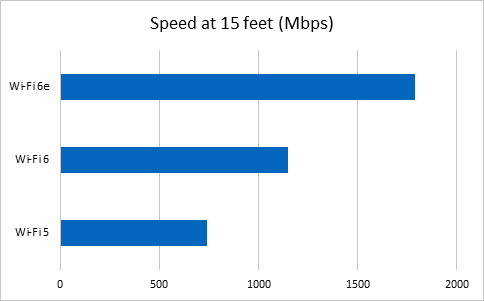Wi-Fi 6 vs Wi-Fi 6e: What's the difference?
Wi-Fi 6 vs Wi-Fi 6e: What'due south the deviation?

While Wi-Fi 6 (aka IEEE standard 802.11ax) currently dominates the sales of home Wi-Fi routers, there's a new wireless information standard on the block, and it could accident away all the others.
Wi-Fi 6e, an extended implementation of 802.11ax, not simply pushes information throughput to the limit by adding more than a gigahertz of wireless spectrum just opens up ultra-wide information channels to be used for everything from online gaming to augmented-reality goggles.
Withal, Wi-Fi 6e routers price a lot more than than their Wi-Fi 6 siblings, and at that place aren't nonetheless many laptops, smartphones or tablets that are compatible with the latest standard. Read on to figure out whether Wi-Fi six or Wi-Fi 6e is correct for you.
Wi-Fi 6
When the first 802.11ax routers appeared in 2019, it was like a jiff of fresh air for wireless habitation networking. Dubbed High Efficiency Wi-Fi, or HEW for brusk, Wi-Fi 6 was a major reworking of the style wireless information traveled through the air and was a large step up from 2012's 802.11ac standard (retroactively rebranded every bit Wi-Fi 5).
In improver to the use of 1024 Quadrature Amplitude Modulation (1024-QAM) to squeeze as much as 25% more data into the same frequency range, Wi-Fi 6 added Orthogonal Frequency-Division Multiple Admission (OPFDMA) to reduce the downtime betwixt bursts of data manual. It could also handle upward to eight independent streams of data to create reliable connections to devices throughout the house.
Wi-Fi 6 tin can send and receive information over both the 2.4- and five-gigahertz (GHz) bands (Wi-Fi v is 5-GHz only) and can move even more data by running a unmarried ultra-wide 160-megahertz (MHz) channel on its v-GHz band.
Perfect for gaming, this information-hog aqueduct is a specialty feature that requires grabbing eight 20-MHz general-purpose channels. In other words, it comes at the expense of less-data-hungry users effectually the house.
The new standard added up to a big increase in available bandwidth for everything from streaming 4K movies to catching upward on ignored emails. For instance, the four Wi-Fi vi routers on our Best Wi-Fi Routers folio moved an average of 1.146 gigabits per 2d (Gbps) at a range of fifteen anxiety in our tests. That's more than one-third faster than the average 739 megabit-per-second (Mbps) rate delivered by our top six Wi-Fi 5 routers.
Want nonetheless more than operation? Read on to see what Wi-Fi 6e tin do for your habitation wireless network.
| Wi-Fi 6 | Wi-Fi 6 | Wi-Fi 6e | |
|---|---|---|---|
| Data delivery rate at 15 feet | 739 Mbps | 1.146 Gbps | 1.788 Gbps |

Wi-Fi 6e
The Wi-Fi 6e specification fabricated its debut on consumer devices in the spring of 2021. In addition to lowering a router's latency to create faster network response, Wi-Fi 6e added more than than a gigahertz of fresh electromagnetic spectrum infinite in the U.S., ranging from 5.925 GHz to 7.125 GHz.
This additional cake of spectrum, more often than not referred as the 6-GHz band, allows routers to create an extra 14 information channels that are 80 MHz wide or every bit many every bit seven heavy-duty 160-MHz-broad data channels. In the existent globe, this means that an online gamer or an augmented-reality-goggle wearer can now grab a 160-MHz channel without starving the rest of the household of data.
Virgin territory as far as Wi-Fi is concerned, the six-GHz realm helps those who live (and often work) in areas crowded with dissimilar Wi-Fi networks, such as apartment buildings. In other words, if information technology'due south difficult to become a reliable connection to your router with a v-GHz network, due to congestion on that band, then Wi-Fi 6e'due south 6-GHz ring will likely work better and deliver more data.
This 6-GHz advantage is also one of Wi-Fi 6e's greatest shortcomings. Higher frequencies hateful shorter range, and the half-dozen-GHz frequency is so high that its range is limited to same-room or adjacent-room connections. Once you lot're out of six-GHz range, the router automatically switches your connection over to a 5-GHz link.
| Wi-Fi 6 | Wi-Fi 6e | |
|---|---|---|
| Information bands | 2.4 and 5 GHz | 2.4, 5 and 6 GHz |
| Number of 160-MHz-broad channels bachelor | 1 (in five-GHz band) | viii (1 in 5-GHz, 7 in half dozen-GHz bands) |
| Mesh capable | Yes | Yes |
Which devices support Wi-Fi 6e?
There's no shortage of Wi-Fi 6e routers, including several mesh kits, now available. The limiting cistron is at the client-device level. At the moment, at that place are Wi-Fi 6e-compatible Windows PCs and Android smartphones, only no Wi-Fi 6e-ready Apple macOS and iOS computers, phones or tablets.
The consequence is that as of early 2022, just a handful of customer systems were available to take reward of the extra speed, such every bit the Samsung Milky way S21 Ultra, Motorola Edge 5G and Google Pixel 6 and Pixel half-dozen Pro smartphones and the Samsung Milky way Volume Pro laptop.
The list of uniform devices is expected to abound in 2022 with dozens of new systems coming out that have the Wi-Fi 6e speed advantage.
Amid the three Wi-Fi6e routers on our Best Wi-Fi Routers page, the average data throughput in our tests was an amazing 1.788 Gbps. Non enough? The Netgear Nighthawk RAXE500 led with ii.396 Gbps of total bandwidth bachelor.
This blows away Wi-Fi 6, was more than than twice equally fast as the typical Wi-Fi 5 router and makes a credible case for ditching gigabit-Ethernet wired local networks, at to the lowest degree for short-range uses.
On the other hand, the kickoff Wi-Fi 6e routers are priced more like a bottle of rare wine than a keg of beer. Netgear offers the Orbi RBKE963 three-piece mesh kit for $i,500, and it is difficult to justify paying that when there are competent Wi-Fi 6 routers that price $150.
As well, bear in heed that the average home broadband speed in the U.S. is currently about 50 Mbps. The fastest broadband that most people tin can buy for their homes tops out at 1 gigabit, or one Gbps — far less than what Wi-Fi 6 can evangelize, non to mention Wi-Fi 6e. Your internet speed won't get much faster if you upgrade from a Wi-Fi 6 router to a Wi-Fi 6e one, although the connection speeds between compatible devices in the habitation may.
At least for the moment, getting a Wi-Fi 6e router makes sense only for homes that take gigabit internet connections from their ISPs and the latest and most expensive Windows and Android client devices. Otherwise, Wi-Fi 6e remains a luxury that almost people don't yet need and can't yet afford.
Source: https://www.tomsguide.com/face-off/wi-fi-6-vs-wi-fi-6e-whats-the-difference
Posted by: featherlansider.blogspot.com


0 Response to "Wi-Fi 6 vs Wi-Fi 6e: What's the difference?"
Post a Comment